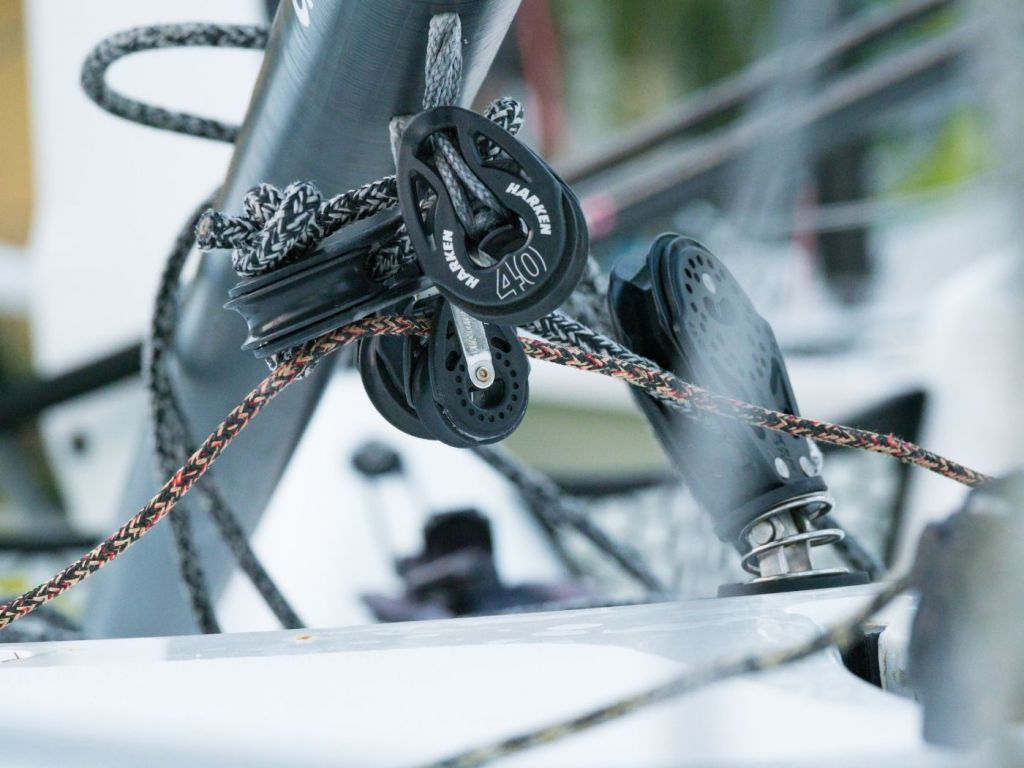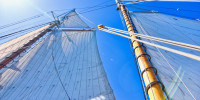Average Cost of Dyneema Rigging (Different Rig Types)
Despite being generally more expensive than traditional wire rigging, Dyneema rigging has become an increasingly popular choice for sailors due to its strength, durability, and lightweight properties. If you're planning to replace your current rigging system with Dyneema, this article will help you find out the average costs associated with Dyneema rigging, as well as the differences in price for various rig types.
Dyneema rigging costs anywhere from $10 to $20 per foot. For sailboats, the price for Dyneema rigging averages from $3,000 to $7,000. However, the actual average cost is still based on factors such as the size of your boat, the specific rigging type, and the choice of materials.
Standing rigging is the most common type on a sailboat and is usually made from stainless steel or steel wire. Constructing it with Dyneema offers plenty of benefits, such as being more corrosion-resistant. Let's look at other types of Dyneema rigging and what advantages they offer.
Summary
- The different types of Dyneema rigging include single-braid Dyneema, Double-braid Dyneema, Dyneema wire, and Dyneema webbing.
- Single-braid Dyneema is usually used for standing rigging, while double-braid Dyneema is used for running rigging.
- Dyneema rigging is resistant to corrosion and does not require lubrication, which saves time and money on maintenance costs.
- Racing boats require more rigging and are subjected to greater stresses, so they need a more expensive, high-performance Dyneema rigging.
- Larger sailboats require more lines and fittings to support the larger sails and rigging loads, which can increase the cost of materials and installation.

On this page:
Average Cost of Dyneema Rigging
Dyneema rigging can cost anywhere from $10 to $20 per foot, with larger boats and thicker rigging costing more. Investing in high-quality Dyneema rigging will likely be more expensive upfront, but can save you money in the long run due to its durability and long lifespan. There are several different types of Dyneema rigging, and each comes with different costs:
| Type of Dyneema Rigging | Estimated Average Cost |
|---|---|
| Single braid Dyneema | $2-4 per foot |
| Double braid Dyneema | $3-6 per foot |
| Dyneema wire | $5-8 per foot |
| Dyneema webbing | $1-2 per foot |
Single-braid Dyneema is suitable for standing rigging
This type of rigging is made from a single braid of Dyneema fibers and is commonly used for applications that require high strength and low stretch, such as standing rigging. The estimated average cost for single-braid Dyneema is around $2-4 per foot.
Generally, the thicker the rope, the more expensive it will be. Additionally, the cost may increase if you require custom splicing or fittings, or if you need to purchase specialized tools for installation. Dyneema standing rigging offers several advantages over traditional materials, such as the following:
- It is significantly lighter than stainless steel or steel wire. This weight reduction can lead to improved performance and maneuverability for your sailboat.
- It offers a high breaking load, making it a strong choice for standing rigging applications.
- Unlike steel wire and stainless steel, it is not susceptible to rust or corrosion, resulting in a longer-lasting rigging solution.
Double braid Dyneema is the best option for running rigging
This type of rigging consists of a braided core of Dyneema fibers that is covered with a braided outer sheath. It is often used for applications that require increased abrasion resistance and durability, such as running rigging.
A double-braid Dyneema costs around $3-6 per foot. It is more expensive than single-braid Dyneema due to the added complexity of the braided construction. However, it is also more durable and can withstand more wear and tear, making it a good investment for applications that require frequent use or exposure to harsh conditions.
Here are some advantages of using double-braid Dyneema for running rigging:
- Double-braid Dyneema has very low stretch, which means that it can maintain its shape and tension even under heavy loads.
- Dyneema fibers are incredibly strong, and double-braid construction adds another layer of durability and abrasion resistance.
- Compared to traditional wire rigging, double-braid Dyneema is much lighter, which can help to reduce overall weight aloft and improve the performance of the boat.
- Double-braid Dyneema is easy to splice, so it can be customized to fit specific applications and hardware. This makes it a popular choice for sailors and riggers who value flexibility and customization.
Dyneema wire is best used in riggings with splicings or traditional wire fittings
This type of rigging is made by combining Dyneema fibers with a thin wire core. It is commonly used in applications where the rigging needs to be spliced or terminated with traditional wire fittings.
The estimated average cost for Dyneema wire is around $5-8 per foot. Compared to traditional wire rigging, Dyneema wire is often more expensive due to the added cost of the Dyneema fibers.
The good thing with Dyneema wires is that it is lighter and more flexible, making it a popular choice for sailors and riggers who value performance and ease of use. They are also lighter than traditional wire rigging, which can be stiff and difficult to work with.
Dyneema webbing is often used for trampolines or lifelines
This type of rigging is made from flat webbing material that is woven from Dyneema fibers. It is usually used in applications that require a wide load-bearing surface, such as trampolines or lifelines.
A Dyneema webbing costs around $1-2 per foot. Compared to other types of rigging, Dyneema webbing is often less expensive due to the simpler construction of the material. However, it is also less durable than other types of Dyneema rigging and may require more frequent replacement over time.
Average Dyneema Rigging Costs For Different Types of Boats
In this section, we will explore the average costs of Dyneema rigging for different types of boats, including cruising boats, racing boats, and performance cruising boats:
| Boat Type | Estimated Average Cost of Dyneema Rigging |
|---|---|
| Cruising Boats | $2,500 - $5,000 |
| Racing Boats | $5,000 - $10,000 |
| Sailboats | $3,000 - $7,000 |
Cost of Dyneema rigging for cruising boats
Cruising boats are typically designed for comfort and leisurely sailing, rather than high-performance racing. As a result, the rigging requirements for cruising boats are not as demanding as those for racing boats. This means that less expensive Dyneema rigging can be used to meet the needs of cruising boats.
Unlike traditional wire rigging, which can corrode and require frequent replacement, Dyneema rigging is resistant to corrosion and does not require lubrication, which saves time and money on maintenance costs. The cost of Dyneema rigging for cruising boats is estimated to range from $2,500 to $5,000.
Cost of Dyneema rigging for racing boats
For racing boats, the cost is generally higher because the rigging requirements are more demanding. Racing boats require more rigging and are subjected to greater stresses than cruising boats. This means that more expensive, high-performance Dyneema rigging is needed to meet the needs of racing boats.
An advantage of Dyneema rigging for these boats is its low stretch properties. Low-stretch rigging reduces the amount of energy lost due to stretch, which can improve the performance of the boat. This can be especially important in racing, where every second counts.
Dyneema rigging is also lightweight, helping to reduce the overall weight of the boat and improving its speed and agility, which, again, is beneficial in racing. The cost of Dyneema rigging for racing boats ranges from $5,000 to $10,000.
Cost of Dyneema rigging for sailboats
Larger sailboats require more rigging, which can increase the cost. Additionally, certain types of sailboats, such as those designed for offshore racing or cruising, may require more expensive rigging to meet the demands of their intended use.
For sailboats in general, Dyneema rigging can provide a number of benefits over traditional wire rigging because it is lightweight, strong, and durable, which can improve the performance of the boat and reduce maintenance costs. The cost of Dyneema rigging for sailboats can range from $3,000 to $7,000.
Length Of Rigging, Boat Size, And Quality Of Dyneema
Now, let's take a look at three key factors that affect the average costs of Dyneema rigging:
The length of rigging required directly influences the overall cost
As a general rule, Dyneema rigging can cost anywhere from $10 to $20 per foot. Naturally, the longer the rigging, the higher the cost.
Try to make sure to accurately measure the length of rigging needed for your boat, as underestimating can lead to insufficient rigging or additional costs if more material is needed later.
The size of the boat and rigging configuration can also impact the cost
Aspects like mast height, shroud angles, and backstay designs play a significant role in determining the complexity of the project and therefore the cost. For different sailboat sizes, the estimated average costs to replace standing rigging are:
| Sailboat Size | Estimated Cost Range of Dyneema Rigging | Complexity of Rigging System |
|---|---|---|
| Small (up to 30 feet) | $2,000 - $5,000 | Simple rigging system with fewer lines and fittings |
| Medium (30 to 50 feet) | $5,000 - $10,000 | More complex rigging system with additional lines and fittings |
| Large (50 feet and above) | $10,000 - $20,000 | Highly complex rigging system with numerous lines and fittings |
If you want to know about the average cost of replacing the standing rigging of different boat sizes, you can refer to this article.
The quality of the Dyneema you use will have an impact on the overall cost as well
High-quality Dyneema products are known for their durability, strength, and low stretch, making them an ideal choice for rigging. However, these higher-grade materials can also come with a higher price tag.
Perhaps consider the trade-offs between cost and quality when selecting the Dyneema for your rigging project, and remember that investing in higher-quality materials now can lead to long-term benefits and lower maintenance costs.
Did you find the answer to your specific question?
👍 0 👎 0




Leave a comment